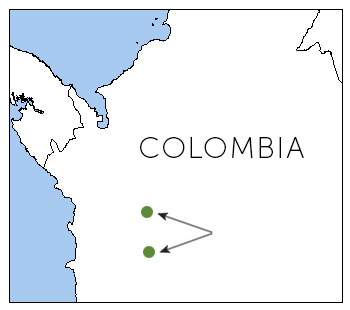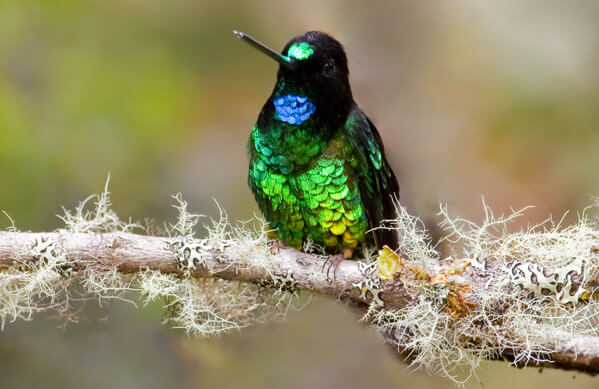 Known only from one specimen for over 50 years, the Glittering Starfrontlet (initially called the Dusky Starfrontlet) was rediscovered in 2004 high in the western Andes of Colombia, an area known as the Cordillera Occidental. Today, it continues to be one of the rarest of all hummingbirds. (The Marvelous Spatuletail of Peru is almost as rare.)
Known only from one specimen for over 50 years, the Glittering Starfrontlet (initially called the Dusky Starfrontlet) was rediscovered in 2004 high in the western Andes of Colombia, an area known as the Cordillera Occidental. Today, it continues to be one of the rarest of all hummingbirds. (The Marvelous Spatuletail of Peru is almost as rare.)
The bird's Spanish name, “Colibrí del Sol,” means “Hummingbird of the Sun.” One look at the beautiful male bird explains the name: green, blue, and golden spots sparkle in the light.
The Glittering Starfrontlet is identified as an Alliance for Zero Extinction species due to its Red List status and limited range; its tiny, declining population is threatened by habitat loss.
Like all other species of the genus Coeligena, this starletfront is a cloud forest hummingbird. Páramo de Frontino, with its forest and adjacent grasslands, is one of only two tiny areas in northwest Colombia where the species can be found. The area also contains rich deposits of gold, zinc, and copper that have attracted the attention of mining companies. Although political instability in the region has prevented further exploitation, the potential for mining remains a threat.
The area is also under great pressure from illegal settlers, who clear the forests for places to live and graze cattle.
Sign up for ABC's eNews to learn how you can help protect birds
Treasure Troves of Rare Birds
Colombia's Páramo de Frontino is home to many other endangered birds: the Critically Endangered Antioquia (Fenwick's) Antpitta, Endangered Chestnut-bellied Flowerpiercer, Vulnerable Rusty-faced Parrot, and Vulnerable Multicolored Tanager.

Although not as stunning as the male, the female Glittering Starfrontlet is still an impressive bird. Photo by Fundación ProAves
Other isolated mountain ranges in Colombia contain similar pockets of rare and endemic species. The Sierra Nevada de Santa Marta, further north, shelters threatened birds such as the Santa Marta Parakeet, Santa Marta Warbler, and Santa Marta Sabrewing. The area also provides wintering habitat for neotropical migrants including the Cerulean Warbler, Golden-winged Warbler, and Swainson's Thrush.
Saving the Glittering Starfrontlet
In 2005, we helped our Colombian partner, Fundación ProAves, establish the Colibrí del Sol Bird Reserve, which protects the Glittering Starfrontlet's core remaining territory. The reserve features some of the most-intact cloud forest and páramo remaining in Colombia and continues to be the only protected area for the species.
More recently, we supported upgrades to facilities at the reserve, including an additional guest cabin and a micro-hydro generator for electricity.
Donate to support ABC's conservation mission!




















































